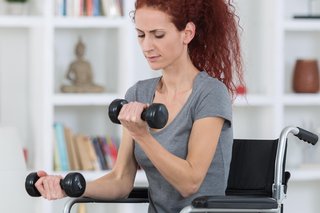
As a wheelchair user, getting active will bring you important health benefits and can help you manage daily life, too.
Regular aerobic exercise – the kind that raises your heart rate and causes you to break a sweat – and muscle-strengthening exercise are just as important for the health and wellbeing of wheelchair users as they are for other adults.
Whatever your preferences and level of physical ability, there will be an activity or sport for you.
Physical activity does not have to mean the gym or competitive sport, though these can be great options. Activity can take many forms and happen in many places.
To improve your health, try to choose activities that improve your heart health and muscle strength.
For general health, all adults aged 19 to 64, including wheelchair users, are advised to do:
- at least 150 minutes a week of aerobic activity, plus
- strength exercises on 2 or more days a week
Do not worry about hitting these targets straight away: it's more important to do something active that you enjoy.
Find out more about physical activity guidelines for adults aged 19 to 64.
Why you should get active
Regular physical activity is good for physical and mental wellbeing, and can be a great way to meet new people.
Find out more about the benefits of exercise.
Using a wheelchair can make it more difficult to do cardiovascular physical activity that raises your heart rate.
Manoeuvring or pushing a wheelchair can also put particular pressure on certain muscles in the upper body, making strains or other injuries more likely.
Muscle-strengthening exercises can help you manage your wheelchair in daily life and avoid these kinds of ailments.
What kind of activity?
The kind of activities that are right for you depend on your level of physical ability and the types of activity that appeal to you.
Your aim might be to improve certain aspects of physical function to help with daily life.
Or you may be seeking improved fitness, or involvement in competitive sport.
Whatever your level of physical ability and confidence, there are activities you can do to improve fitness.
Cardiovascular exercise
There's a range of options available for taking cardiovascular exercise in a wheelchair.
The aim is to raise your heart rate and be warm enough to break a sweat.
You should be slightly out of breath: enough that you can still hold a conversation, but not sing the words of a song.
If you are not used to exercise or you have not exercised for some time, aim to start with 10-minute sessions and gradually build up towards 20 minutes.
Activity ideas may include:
- swimming
- sitting exercises
- wheelchair workouts
- wheelchair sprinting – in a studio or at a track
- using a rowing machine adapted for wheelchair use
- wheelchair sports such as basketball, netball and badminton
Muscle-strengthening exercise
When it comes to muscle-strengthening exercise, you should pay special attention to certain muscle groups.
The repeated pushing motion used to push a wheelchair means that the chest and shoulder muscles can become tight and prone to injury.
Meanwhile, the back muscles can become weaker. This is because they are not the main muscles used in this pushing motion and are not worked as much.
Because of this, it's a good idea to focus on exercises that work the smaller muscles that support the pushing motion, such as the shoulder muscles. This can help prevent injury.
You can also strengthen the back muscles by doing exercises that involve a pulling motion, such as a pull-up.
Gyms with equipment adapted for wheelchair users are a great place to do muscle-strengthening activities.
Some wheelchair users also find they can do muscle-strengthening exercises at home using resistance bands.
Get started
There are various ways to learn more about activities that are right for you and find local facilities.
- Parasport is an organisation dedicated to helping disabled people get involved in sports. Find a local opportunity on the Parasport website.
- The Activity Alliance runs the Inclusive Fitness Initiative (IFI), a scheme that ensures gyms are suitable for use by people with disabilities. Find inclusive gyms on the Activity Alliance website.
- Your local recreation centre must ensure it provides access to wheelchair users, according to the Disability Discrimination Act (GOV.UK). If you have questions about your local recreation centre, such as what specialist equipment they have or whether there are special sessions for wheelchair users, call ahead and ask.
Video: how to keep fit with a disability
This video gives tips on how to find the right gym or do exercise at home with a disability.
Media review due: 1 June 2026
Self-refer for help with your weight
If you need help managing your weight, you might be able to refer yourself directly to services that can help you, without seeing a GP.
To find out if there are any services in your area:
- ask the reception staff at your GP surgery
- check your GP surgery’s website
- contact your integrated care board (ICB) – find your local ICB
- search online for NHS weight management services near you